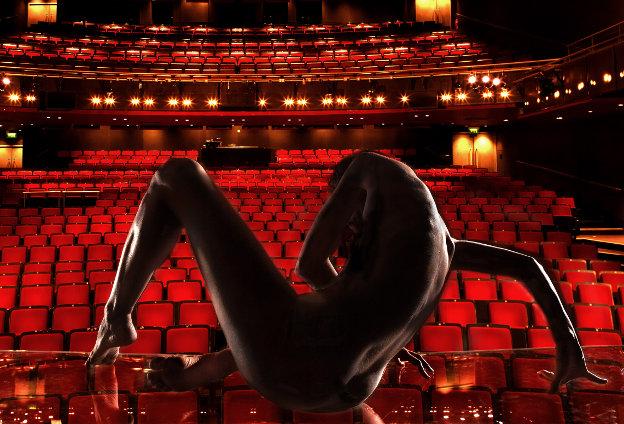There aren’t many artistic directors of theatres with a capacity of 1500 seats who would commission a show for an audience of only 200. Yet that is exactly what Alistair Spalding of Sadler’s Wells has done for Clod Ensemble’s An Anatomie in Four Quarters, which although it doesn’t quite live up to its potential, nevertheless playfully explores the structure of watching live performance.
Beginning in the cheap seats of the second circle, a tall, thin woman dances alone on the vast and bare stage. As the lights fade on her, our attention is drawn to a couple a few rows ahead of us, whispering about the performance. Who are they? Why have they come to the theatre this evening? Why have we come to the theatre this evening, and how do our relationships and proximity to performances affect our experience Suddenly, the dancer who seemed so distant when onstage is repeating her fluid choreography ten rows in front of us. We can hear her breath and see her muscles flexing as she moves confidently through Suzy Wilson’s choreography.
It’s an exciting beginning, but director Suzy Wilson’s hour-long piece barely scratches the surface of the idea. Instead, the show is quite clinical and cold. We move from the second circle, to the first, to the stalls and ultimately the stage where we move amongst the dancers before sitting to face the seats in which we started watching. During each section twelve charismatic dancers repeat a vocabulary of phrases, which seem to explore human form – from all fours to sitting, standing, jumping, falling, to doing the splits. A live band of strings, bagpipes and drums switch from beautifully composed classical refrains to the shrieks of a rock band.
Weaved through the experience are the couple sitting in the second circle who remain watching from their seats throughout. It seems that they should connect the entire piece together. However, the woman recounts obscure poetry that never illuminates the choreography, music or space. The most stimulating moments are theatrical surprises such as a chorus of feet dancing above our heads amongst the lighting rig, and being allowed to sit right next to a bare-chested opera singer splayed out on a table with his eyes closed in the middle of the stalls as he serenades us. I hope there will be more of these moments when Clod take the show on the road in 2012.


